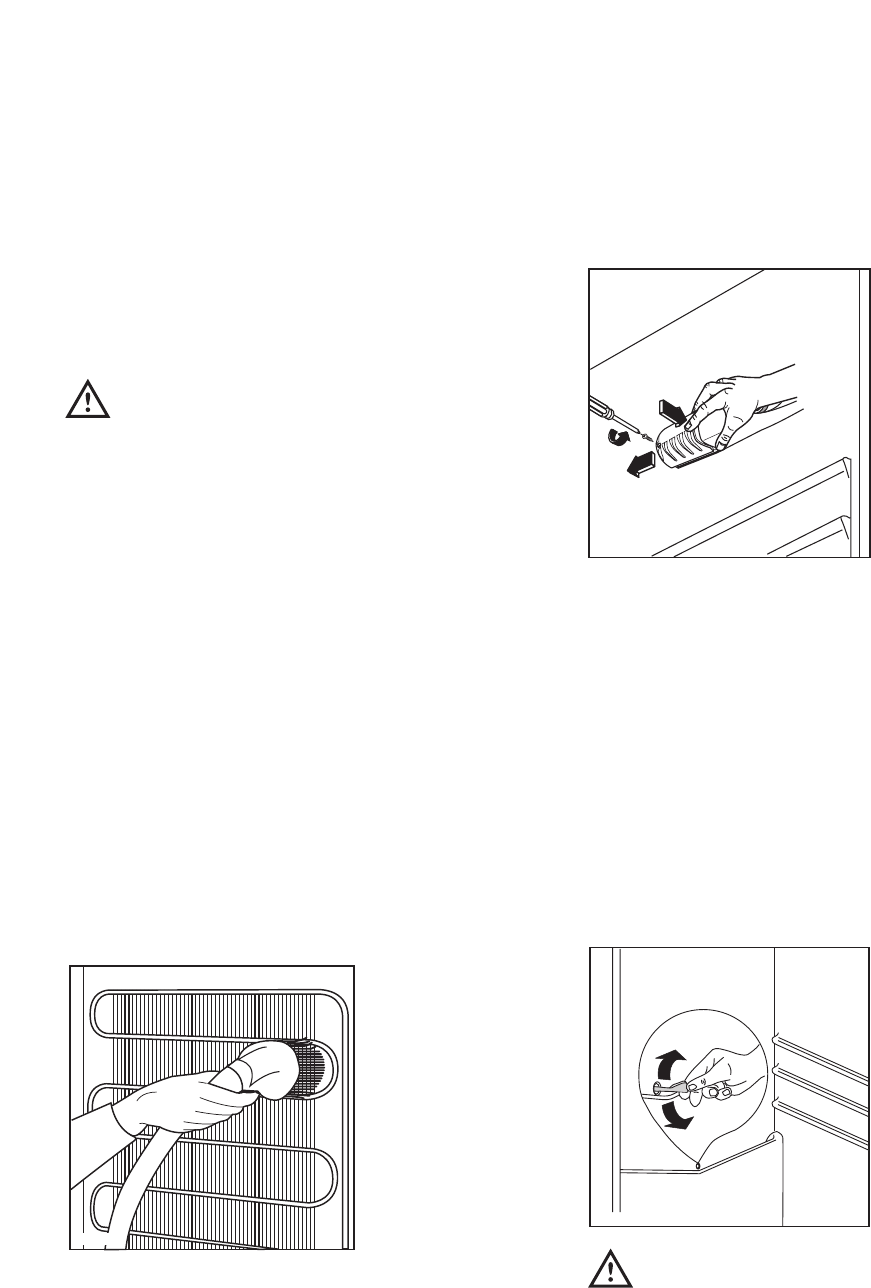
10
Defrosting
Refrigerator
The refrigerator automatically defrosts every time the
compressor stops. The water is discharged, via the
pipe, into a tray located at the back of the appliance
above the compressor, where it evaporates.
Important
To avoid defrost water overflowing into the fridge,
periodically clean the water discharge hole in the centre
of the V shaped drip collector at the back of the
refrigerator compartment behind the fruit and vegetable
drawer. Use the defrost cleaner provided which you will
find already inserted into the discharge hole.
Remember to wash the defrost cleaner in hot soapy
water at regular intervals. Dry throughly before
replacing.
D037
MAINTENANCE AND CLEANING
External cleaning
Many proprietary kitchen surface cleaners
contain chemicals that can attack/damage the
plastics used in this appliance. For this reason it
is recommended that the outer casing of this
appliance is only cleaned with warm water with a
little washing-up liquid added.
An accumulation of dust will affect the performance
of the appliance and cause excessive electricity
consumption.
You MUST ensure that the appliance is switched
OFF
Once or twice a year dust the condenser (black grill)
and the compressor at the back of the appliance,
with a brush or vacuum cleaner, see figure.
PR259
Before any maintenance or cleaning work is carried
out, DISCONNECT the appliance from the
ELECTRICITY supply.
Internal cleaning
Clean the inside and accessories with warm water
and bicarbonate of soda (5ml to 0.5 litre of water).
Rinse and dry thoroughly.
NEVER USE DETERGENTS, ABRASIVE
POWDERS, HIGHLY PERFUMED
CLEANING PRODUCTS OR WAX
POLISHES, TO CLEAN THE INTERIOR AS
THESE WILL DAMAGE THE SURFACE AND
LEAVE A STRONG SMELL.
Changing the light bulb
Should the interior light fail to work, first switch off
the appliance and disconnect from the electricity
supply, then replace the bulb as follows;
Unscrew the light cover and then pull it outward by
pressing as shown in the figure. Unscrew the bulb
and replace it with a new 15 watt bulb (available
from your nearest Service Force Centre).
Replace the light cover by sliding it into its original
position and replacing the screw.
D411
When the appliance is not in use
When the appliance is not in use for long periods,
disconnect from the electricity supply, empty all
foods and clean the appliance, leaving the doors ajar
to prevent unpleasant smells.
11
Freezer
When the frost has reached a thickness of up to
4mm it can be removed using the ice scraper
provided with the appliance. During this operation it
is not necessary to disconnect the appliance from
the mains and remove the food. Never use metal
tools for this operation.
For complete defrosting (once or twice a year)
proceed as follows:
- turn the thermostat dial to the «OFF» position (O)
or disconnect the appliance from the mains.
- Remove any food from inside the freezer and
fridge, wrap it in several sheets of newspaper and
store in a cool,dry place.
- Leave the door open and insert the ice scraper
under the channel in the centre of the lower part
of the appliance; place a low-sided container
beneath the scraper to collect the water (see fig.).
- Clean and dry thoroughly.
- Replace the scraper in one of the drawers .
- Reconnect the appliance to the mains or reset
the thermostat to a functioning position.
- After letting the appliance run for at least half an
hour, replace the previously removed food into
the compartment.
Important
When defrosting the freezer, the fridge is also
controlled by the thermostat and will not be
operational during this period. A temperature rise of
the frozen food packs, during defrosting, may
shorten their safe storage life.
Attention!
In the event of a power failure causing the
temperature within your freezer to rise, do not re-
freeze the food without checking its condition.
The following guidelines should assist you.
Ice-cream: once thawed should be discarded.
Fruits & Vegetables: if soft should be cooked and
used up.
Breads & Cakes: can be re-frozen without danger.
Shellfish: should be refrigerated and used up
quickly.
Cooked Dishes: i.e. casseroles should be
refrigerated and used up.
Large Pieces of Meat: can be re-frozen providing
there are still ice crystals remaining within them.
Small Joints: should be cooked and can then be re-
frozen as cooked dishes.
Chicken: should also be cooked and re-frozen as a
cooked dish.
D068/2


















